The Exhibit "The Art and Science of Healing: From Antiquity to the Renaissance", is now gone from the Kelsey Museum and the Audubon Room of the Hatcher Library, but we can still see it through the eyes of undergraduate student Noah Waldman, who last semester wrote an exhibit critique for professor Aileen Das' class, "Ancient Medicine in Greece and Rome". Selected by Dr. Das, I am very pleased to post this review in our Special Collections blog. Readers might also recall that we had previously published another exhibit critique by a student from the same class.
The Art and Science of Healing: From Antiquity to the Renaissance - Exhibition Critique/Review
By Noah Waldman
Creating an exhibit from scratch, in any discipline, is not a task meant for the feeble-minded. It takes considerable vision for a scholar to craft an exhibit with a clear purpose and narrative, and it appears that Pablo Alvarez took on this task with great success. Medical history, especially, is a complex and diverse realm of study where absolutes are nearly non-existent and the works themselves are truly a testament to the incredible observational skills and minds of renown thinkers. In the annals of medicine, there lies a unique blend of theories, methods, and tools that we find either acceptable or repugnant, and the job of scholars like Dr. Alvarez is to sort through these items, and present them in an appealing, yet informative way to both the average museum-goer, as well as his professional contemporaries. Dr. Alvarez and the team at the Kelsey Museum focused on major themes including the role of religion and magic in healing, Graeco-Roman influence on later methods of treatment, and the dynamic nature in which medical texts underwent translation and reinterpretation by scores of authors throughout history. The exhibit demonstrates the driving force of progress and rational influence on the medical field, while displaying how recurrent ideas from antiquity still influenced thought, even up through the Renaissance and pre-modern periods.
A major unifying theme that Dr. Alvarez emphasized in the exhibit was the role of religion and magic throughout medical history. Besides dedicating an entire section and banner to this component of the walkthrough, one could see hints of it popping up throughout the length of the show. Dr. Alvarez demonstrates this trend, like most of his other points, through the artifacts and pieces of literature displayed. Fever and sciatica amulets, palindromic inscriptions, and mystical Coptic incantations and recipes were just a few of the artifacts included in driving home the role that the divine played in ancient, as well as pre-modern medicine. Even the physical location of certain artifacts suggested an intentional connection between shared concepts. An example of this was the juxtaposition of the six Egyptian uterine amulets (1st-5th c. AD) with a magnified facsimile of a full page woodcut of Johannes de Ketham’s sixteenth century "Seated Woman" from Fasciculus medicinae.
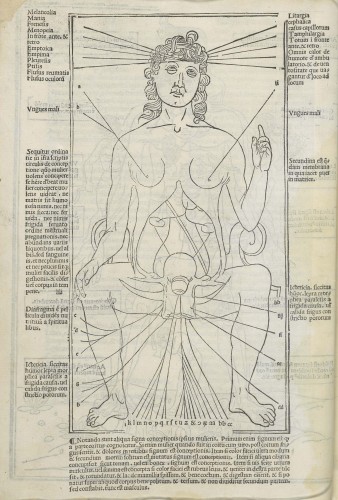
Woodcut depicting a "Seated Woman" from Johannes de Ketham (fl. 1455-1470). Fasciculus medininae. Venice: Cesare Arrivabene, 1522; The Le Roy Crummer Collection
Having these very visual artifacts close together suggests relatedness in purpose, which their descriptions also convey. Although these two objects were separated temporally and geographically, they were both pieces emphasizing the same features of women’s bodies, and aiming at the treatment of obstetric and gynecological ailments. In a similar vein, the displayed clay figurine of Isis-Aphrodite demonstrated the synchronicity between Egyptian and Greek divine healing, aimed at protecting the mother and her child during the dangerous process of parturition.
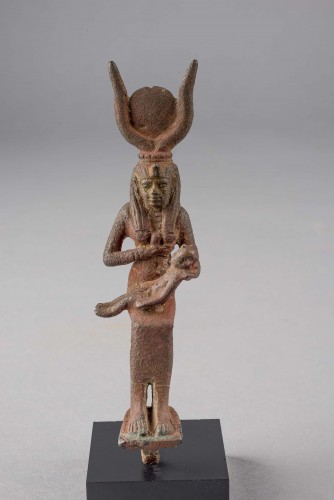
Isis Nursing Horus. Fayum. Egypt; 332 BC-200 AD; Bronze; 115 x 275 x 28 mm; KM 3130; David Askren, 1925
However, as Dr. Alvarez demonstrated, mystical healing went far beyond women’s health. In particular, the magical codex from the Coptic Wizards Hoard showcased the use of amulets and recipes against toothaches, headaches, fevers, and gout, demarcating a well-placed transition in the exhibit.
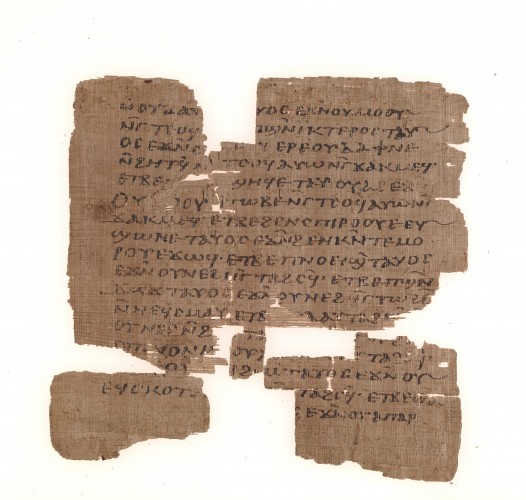
Magical Codex from The Coptic Wizard’s Hoard
Egypt; in Coptic; 4th–7th c. ad
Papyrus; page 6; 155 x 154 mm
P. Mich. inv. 593
This artifact’s location between the religion and magic section and the Graeco-Roman section of the exhibit is indicative of the dual nature of the artifact itself. Preparing recipes and salves to target disease was a largely Hippocratic, rational means of treatment, yet within the same text, instruction on how to write an incantation was included. This duality in treatment is a trend in Egyptian medicine we have observed in class as well (as papyrus was an expensive material, so writing both approaches on one scroll was the most sensible, cost-efficient method).
As medicine progressed, more material was authored than ever before, and this intensity was reflected in the frequency of textual evidence that Dr. Alvarez and the Kelsey team presented, starting at the Graeco-Roman banner of the exhibit. The Hippocratic Corpus brought dozens of works to the attention of thinkers around the Mediterranean, and it seemed like Dr. Alvarez paid careful attention to highlight the diversity in theory of Graeco-Roman authors. As easy as it would have been to group them all together, a key difference emphasized was how although many Hippocratic thinkers cited what we now term “rational” causes of pathology, not all fit so neatly in to that category. Artifacts like de Ketham’s "The Zodiac Man" showed how the Graeco-Roman practice of using astrological evidence influenced healthcare not only in the classical era, but all the way through the pre-modern period.
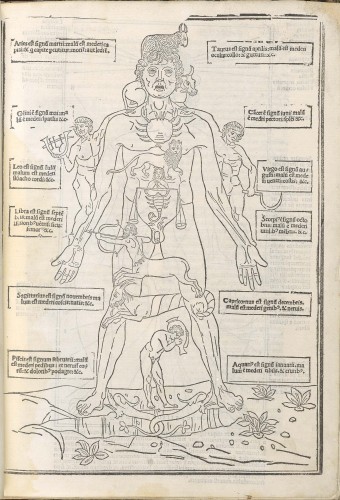
Woodcut depicting the "Zodiac Man" from Johannes de Ketham (fl. 1455-1470). Fasciculus medininae. Venice: Cesare Arrivabene, 1522; The Le Roy Crummer Collection
This section was thoughtfully contrasted with descriptions of Galenic thought, as well as Pedanius Dioscorides’ De Materia medica. I believe Dr. Alvarez’s choice to put De Materia medica where he did made sense chronologically and content-wise. The highly categorical nature of the text, describing minerals, plants, animals, and specific treatments, helped transition to the following display case of medical tools. Roman Imperial sling pellets, accompanying texts, and de Ketham’s depiction of "The Wound Man" also provided large, visually appealing pieces that helped the transition from Graeco-Roman to Medieval medicine. As previously mentioned, the presentation of a wide range of scoops, probes, forceps, and tweezers suggested a more widespread, practice-based variation of medicine as time progressed. However, the tools themselves could not tell the whole story. Dr. Alvarez skillfully included texts that supplemented and explained the intended use of these tools. This part of the exhibit was my favorite for that reason. I could envision an iatros extracting maggots from someone’s ear using a wax-covered probe, a technique he learned from his father, who may have had access to the same text we were looking at in the Kelsey.
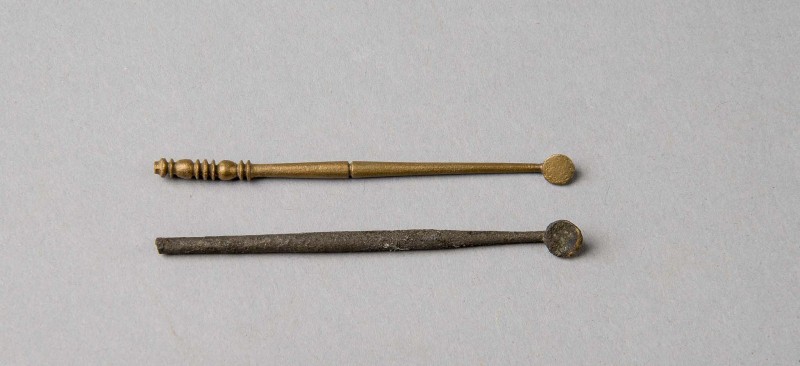
(upper) Ear Probe Karanis, Egypt; Roman period Bronze; 65 x 5 mm; KM 21391; University of Michigan Excavations, 1935. (lower)Ear Probe; Rome; Roman period; Bronze; 65 x 6 mm; KM 21501; Francis W. Kelsey, 1901
When maggots have appeared, if they are near the surface, they must be extracted by an ear scoop; if further in they must be killed by medicaments, and afterwards care taken that they do not breed (Aulus Cornelius Celsus (fl. 25 AD). De Medicina, 6.7.5)
Finally, the presentation of Medieval Islamic and Latinized texts such as Secretum Secretorum and Albucasis’ Chirurgia cum formis instrumentorum displayed a spurt of progress in surgical advancement, as well as artistic depictions of the tools used in treating a wide range of ailments.
![Albucasis [Abū al-Qāsim Khalaf ibn al-‘Abbās az-Zahrāwī (936–1013)] Chirurgia cum formis instrumentorum (Trans. Gerardus Cremonensis). Venice: Bonetus Locatellus, for the heirs of Octavianus Scotus, 27 Jan. 1500/1 The Le Roy Crummer Collection](/sites/default/files/blogs/readingroom/figure_4.14.jpg)
Albucasis [Abū al-Qāsim Khalaf ibn al-‘Abbās az-Zahrāwī (936–1013)]
Chirurgia cum formis instrumentorum (Trans. Gerardus Cremonensis). Venice: Bonetus Locatellus, for the heirs of Octavianus Scotus, 27 Jan. 1500/1
The Le Roy Crummer Collection
In the later middle ages, Muslim translators and doctors, in addition to educators at newly centralized European universities, played a large role in the transformation of the art of Medicine to a discipline that was more graphically represented and detailed than ever before. In the aforementioned text, Albucasis describe a tonsillectomy in detail, with an illustration of the proper tool to use. As Dr. Alvarez mentioned on the walking tour, these thick texts were often so large because the professors would lecture directly out of them. Yet Dr. Alvarez made sure to incorporate the magical/religious aspects still present in medieval thought. The textual formation of inverted isosceles triangles, palindromic words, and the use of the renowned phrase abracadabra represented medicine’s reluctance to let go of mystical treatment of disease, even hundreds of years after antiquity.
Overall, Dr. Alvarez and employees of the Kelsey museum put the exhibit together in a clear, logical manner, which made even more sense coming in with the background knowledge from our class. The exhibit was physically laid out in a way that supported movement that matched with the narrative Dr. Alvarez was trying to tell. I believe that an individual lacking any previous study of ancient medicine would have still had a good chance at taking home the general sense of continuity that Dr. Alvarez presented. His decision to use QR codes as a practical means of giving inquisitive people the option for more, without flooding the average viewer with information, was a great choice. Finally, I think the decision to separate the Renaissance portion of the exhibit, while still giving a taste of it through displaying magnified replicas of six woodcuts of Vesalius’ muscle men from De humani corporis fabrica libri septem, was a smart decision (in the practical way that it saved space in the Kelsey, as well as providing a barrier for the disconnect in time/content). The lighting, page presentation, and accessibility of the exhibit was masterfully done. However, I think it may have been more visually intriguing for the different sections and banners to be color coated, for clarity and aesthetics. Although, once again, I believe Dr. Alvarez was successful in providing the viewer with an informative narrative that highlighted the development of the art of medicine through the ages, while emphasizing recurring themes like religion and magic.
The Art and Science of Healing: From Antiquity to the Renaissance
Kelsey Museum of Archaeology & Audubon Room at the Hatcher Library
February 10-April 30 2017
Visit the online version of the exhibit here